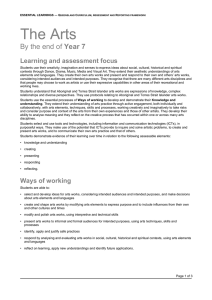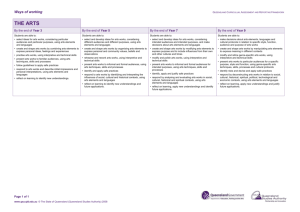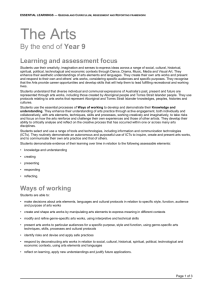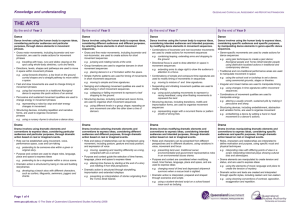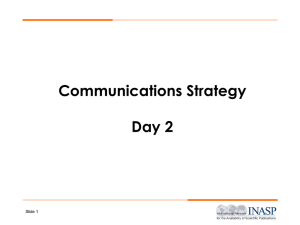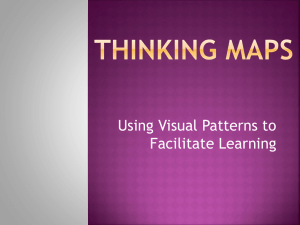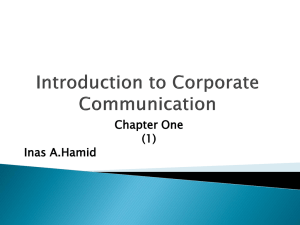The Arts - Queensland Curriculum and Assessment Authority
advertisement
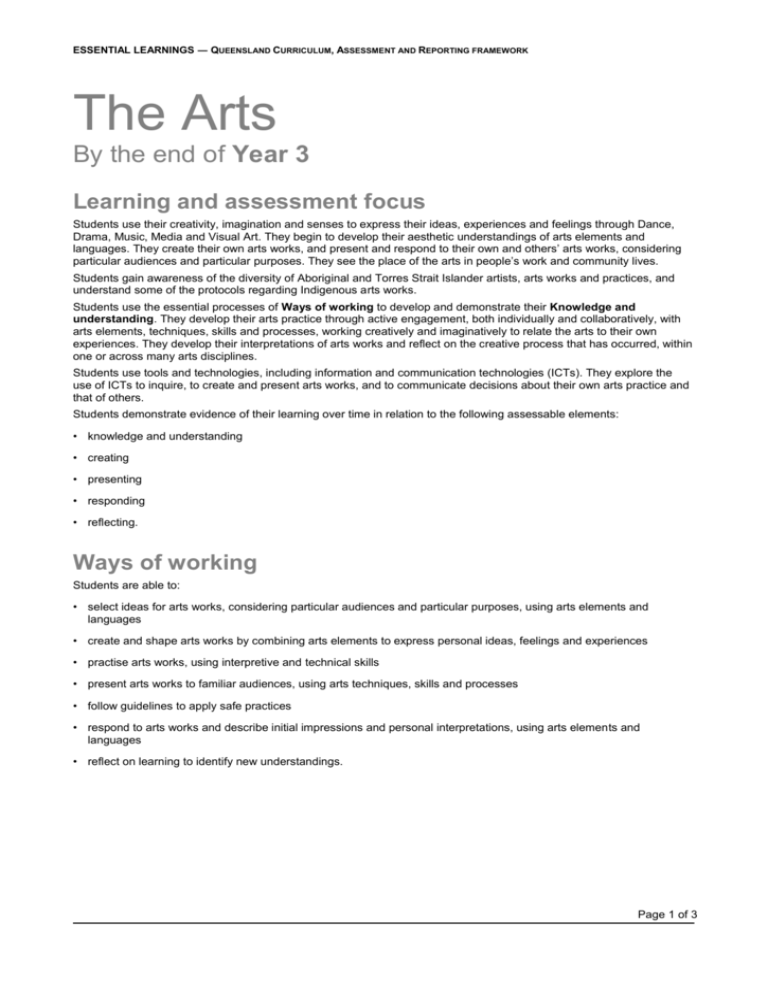
ESSENTIAL LEARNINGS ― QUEENSLAND CURRICULUM, ASSESSMENT AND REPORTING FRAMEWORK The Arts By the end of Year 3 Learning and assessment focus Students use their creativity, imagination and senses to express their ideas, experiences and feelings through Dance, Drama, Music, Media and Visual Art. They begin to develop their aesthetic understandings of arts elements and languages. They create their own arts works, and present and respond to their own and others’ arts works, considering particular audiences and particular purposes. They see the place of the arts in people’s work and community lives. Students gain awareness of the diversity of Aboriginal and Torres Strait Islander artists, arts works and practices, and understand some of the protocols regarding Indigenous arts works. Students use the essential processes of Ways of working to develop and demonstrate their Knowledge and understanding. They develop their arts practice through active engagement, both individually and collaboratively, with arts elements, techniques, skills and processes, working creatively and imaginatively to relate the arts to their own experiences. They develop their interpretations of arts works and reflect on the creative process that has occurred, within one or across many arts disciplines. Students use tools and technologies, including information and communication technologies (ICTs). They explore the use of ICTs to inquire, to create and present arts works, and to communicate decisions about their own arts practice and that of others. Students demonstrate evidence of their learning over time in relation to the following assessable elements: • knowledge and understanding • creating • presenting • responding • reflecting. Ways of working Students are able to: • select ideas for arts works, considering particular audiences and particular purposes, using arts elements and languages • create and shape arts works by combining arts elements to express personal ideas, feelings and experiences • practise arts works, using interpretive and technical skills • present arts works to familiar audiences, using arts techniques, skills and processes • follow guidelines to apply safe practices • respond to arts works and describe initial impressions and personal interpretations, using arts elements and languages • reflect on learning to identify new understandings. Page 1 of 3 ESSENTIAL LEARNINGS ― QUEENSLAND CURRICULUM, ASSESSMENT AND REPORTING FRAMEWORK Knowledge and understanding Dance Dance involves using the human body to express ideas, considering particular audiences and particular purposes, through dance elements in movement phrases. • Gross motor movements, including locomotor and non-locomotor, are used to create actions for movement phrases e.g. travelling with hops, runs and slides; staying on the spot using whole-body stretches, curls and twists. • Directions, levels, shapes and pathways are used to move in space within movement phrases e.g. using forwards direction, a low level on the ground, curved shapes and a straight pathway to move within a space. • Fast and slow movements are used to change timing in movement phrases e.g. using fast movements in a traditional Aboriginal dance to express the quick actions of an animal. • Percussive and sustained movement qualities are used to change energy in movement phrases e.g. representing a robot by stop-and-start energy changes in movement. • Structuring devices, including repetition and narrative forms, are used to organise movement phrases e.g. using a nursery rhyme to structure a dance story. Drama Drama involves using dramatic elements and conventions to express ideas, considering particular audiences and particular purposes, through dramatic action based on real or imagined events. • Role can be established using movement, voice, performance space, cues and turn-taking e.g. pretending to be someone else within a given or original story. • Purpose and context are used to shape roles, language, place and space to express ideas e.g. pretending to be a ringmaster within a circus scene. • Dramatic action is structured by being in role and building storydramas e.g. developing a beach story with different characters, such as surfers, lifeguards, swimmers, joggers and sharks. Media Media involves constructing meaning by using media languages and technologies to express representations, considering particular audiences and particular purposes. • Still and moving images, sounds and words are used in media texts e.g. using still and moving images, sounds and words in a television advertisement. • Media techniques and practices, including crop, print, record/capture and sequence images, sounds and words, are used to create media texts e.g. cropping a digital image to create a close-up from a long shot. • Representations in media texts can be either real or imagined, and are created for particular audiences and purposes e.g. using animal characters in sketches and drawings for a children’s film on road safety. Page 2 of 3 ESSENTIAL LEARNINGS ― QUEENSLAND CURRICULUM, ASSESSMENT AND REPORTING FRAMEWORK Music Music involves singing, playing instruments, listening, moving, improvising and composing by using the music elements to express ideas, considering particular audiences and particular purposes, through sound. • Duration, beat, time values and metre are used to create repeated rhythmic patterns e.g. using minims, crotchets, quavers, semiquavers and crotchet rests to create rhythmic ostinatos in simple time. • Pitch and intervals are used to create melodic phrases and sequences e.g. using an improvised melody to accompany a known nursery rhyme. • Repetition is used to structure music e.g. using the same, similar and different phrases within a known song. • Familiar sound sources, including vocal and instrumental sources, have characteristic sound qualities (tone colour) e.g. hearing the mellow tone of a cello, compared with the bright sound of a trumpet. • Relative softness and loudness of sounds are used to change the dynamic level of music e.g. using forte (f) to sing loudly or piano (p) to play softly. Visual Art Visual Art involves using visual arts elements, concepts, processes and forms (both 2D and 3D) to express ideas, considering particular audiences and particular purposes, through images and objects. • Warm (red, orange, yellow) and cool (blue, green, purple) colour schemes, and mixed and complementary colours, are used to create tone and variation e.g. using cool colours to suggest calm in a paper and glue sculpture about dreams and sleep. • Line is used to suggest movement and direction e.g. using heavy, straight lines to suggest the swiftness of a cheetah running or soft, squiggly lines to suggest the slowness of a flowing river. • Regular, irregular, open, enclosed, overlapped and adjacent shapes are used to create categories and position e.g. using a variety of rectangular shapes together in a painting to represent buildings in a town. • Texture is used to create variation and repetition e.g. using rough and smooth fabrics and paper to create different surfaces in a collage. Page 3 of 3
